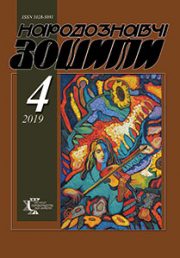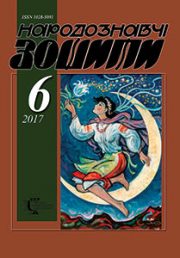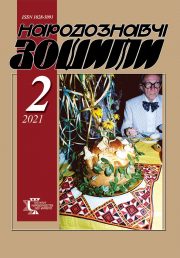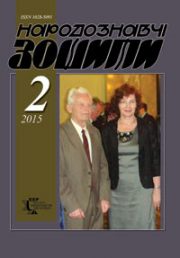The Ethnology Notebooks. 2017, 2 (134), 319—326
UDK 39:728.1:631.273(477.8611)
DOI https://doi.org/10.15407/nz2017.02.319
FENCE IN THE BUILDING CULTURE OF POKUTTIA: CONSTRUCTIONAL TYPES AND VERSIONS
Radovych Roman Bohdanovych, Candidate of Sciences in History, Ph.D, research fellow
in the Department of Historical Ethnology
of the Institute of Ethnology of the National Academy of Sciences of Ukraine.
Svobody Avenue 15, 79000, Lviv, Ukraine.
Contacts: Tel. (067)7117846; e-mail: radovychroman@gmail.com
ORCID ID: http://orcid.org/0000-0002-1900-8948
Abstract. Main types of fences (horizontal and vertical weaved «ploty», wooden «parkany», «vorynnia», stone «mury» and different combinations of them), which were used for estates and yards enclosing at the territory of Pokuttia, are considered in the article. Their constructional versions, building materials specific and technology of construction are revealed. Some special attention is paid to the process of settling of entrance gates («vorota», «brama»), wickets etc.
Keywords: Pokuttia, estate, yard, fence, entrance gate, wicket.
Received 15.03.2017
REFERENCES
Arkhiv L’vivs’koho muzeiu narodnoi arkhitektury ta pobutu (dali — Arkhiv LMNAP). ZV-11. 45 ark. [in Ukrainian].
Arkhiv LMNAP. ZV-17. 41 ark. [in Ukrainian].
Arkhiv LMNAP. ZV-17 (Dodatky. T. 1). 68 ark. [in Ukrainian].
Arkhiv LMNAP. ZV-75. 30 ark. [in Ukrainian].
Vovk, Khv. (1995). Etnohrafichni osoblyvosti ukrains’koho narodu In Vovk Khv., Studii z ukrains’koi etnohrafii ta antropolohii. (pp. 39—218). Kyiv: Mystetstvo [in Ukrainian].
Kosmina, T.V. (1980). Sil’s’ke zhytlo Podillia (kinets’ XIX—XX st.): istory-ko-etnohrafichne doslidzhennia. Kyiv: Naukova dumka [in Ukrainian].
Pan’kiv, M. & Derkach, I. (1994). Sadyba na Pokutti (kinets’ XIX — pochatok XX st.). Ivano-Frankivs’k [in Ukrainian].
Rusov, M. (1915). Typy sil’s’kykh selysch v poludnevij chastyni Halychyny. In Zbirnyk pryrodnycho-tekhnichnoi sektsii Ukrains’koho Naukovoho Tovarystva v Kyivi (Kn. 3, pp. 77—221). Kyiv: Drukarnia Druhoi Drukars’koi Artily, Velyka Volodymyrs’ka 43 [in Ukrainian].
Chubinskij, P.P. (1877). Malorossy Jugo-Zapadnogo kraja: zhilishhe, utvar’, hozjajst-vennye postrojki i orudija. In Trudy jetnografichesko-statisticheskoj jekspedicii v Zapadno-Russkij kraj, snarjazhennoj Russkim Geograficheskim obshhestvom Jugo-Zapadnogo otdela. (Vol. 7., Vyp. 2, pp. 339—606). Sankt-Peterburg [in Russian].
Yakymovych, H. (2013). Typy selians’kykh ohorozh na Bukovyni-Pokutti v kin. XIX — poch. XX st. In Problemy zberezhennia, vidtvorennia ta populiaryzatsii istoryko-kul’turnoi spadschyny v konteksti diial’nosti muzeiv prosto neba : materialy pershoi mizhnarodnoi konferentsii. (Vol. 1., pp. 361—370). L’viv: Apriori (Naukovyj zbirnyk Muzeiu narodnoi arkhitektury ta pobutu u L’vovi) [in Ukrainian].
Bauger, J.A. (1899). Powiat Trembowelski. Szkis geografichno-historychny і etnografichny. Lwów [in Polish].
Falkowski, J. & Fiszera, A. (Ed.). (1938). Pólnocno-wschodnie pogranicze Huculszczyzny (Vol. 4). Lwów (Pracy etnograficzny. Wydawnictwo Towarzystwa ludoznawczego we Lwowie) [in Polish].
Kolberg, O. (1882). Pokucie: Obraz etnograficzny. (Vol. 1). Kraków: W drukarni uniwersytetu jagellońskiego [in Polish].
Kraszewski, J.I. (2000). Wspomnienia Wołynia Polesia I Litwy. Gdańsk: Copyright by Tower Press [in Polish].
Moszyński, K. (1929). Kultura ludowa słowian. (Cz. 1: Kultura materjalna). Kraków [in Polish].
Mroczko, Fr. X. (1897). Śnatyńszczyzna. (Vol 1). Lwów: Z drukarni Władysława Łozińskiego [in Polish].
Zawadzki, W. (1869). Obrazy Rusi Cherwonej (Z rysunkami J. Kossaka). Poznań: Nakładem Jana Źupańskiego [in Polish].







